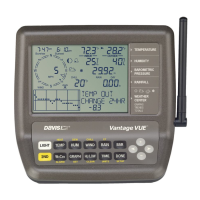Setup Mode
13
Screen 14: Rain Season
Because rainy seasons begin and end at different times in different parts of the
world, you must specify the month you wish your yearly rain data to begin.
January 1
st
is the default setting.
The date the rain season begins
affects yearly rain rate highs and
lows as well as the yearly rain
totals.
1. Press the + and - keys to select
the month for the start of the
rainy season.
2. Press DONE to move to the next screen.
Note: This setting determines when the yearly rain total is reset to zero. Davis Instruments
recommends a January rain season setting (the default), unless you reside on the west
coast of the United States, the Mediterranean Coast, or experience dry winters in the
southern hemisphere. If so, change the rain season setting to July 1
st
. If you are
performing hydrology studies in any of these climates in the Northern Hemisphere,
change the rain season setting to October 1
st
.
Screens 15 and 16: Cooling and Heating Degree Day Base
The Cooling and Heating Degree Day Base screens let you determine the
temperature base that is used to calculate the number of cooling or heating
degree days. A cooling degree day is used to determine the amount of energy
or fuel used to keep a structure like your home or business cool. A heating
degree day is used to determine the amount of energy or fuel used to keep a
structure like your home or business warm.
One cooling degree/day is the amount of cooling required to keep a structure
cool when the outside temperature remains 1°F above the 65°F threshold for 24
hours. One cooling degree/day is also the amount of cooling required when the
temperature remains 24°F above the 65°F threshold for one hour.
One heating degree/day is the amount of heat required to keep a structure
warm when the outside temperature remains 1°F below the 65°F threshold for
24 hours. One heating degree/day is also the amount of heat required when the
temperature remains 24°F below the 65°F threshold for one hour.
The cooling and heating degree days (similar to growing degree days and
chilling requirement in agriculture) are used for agricultural purposes, to
determine crop planting, disease and pest management and harvesting. Our
optional WeatherLink software (#6510USB, 6510SER, 6555) makes advanced
calculations using the degree day totals. Our optional Agricultural/Turf
Management Software Module (#6511) adds the special reporting features to
the WeatherLink software that include evapotranspiration and chilling
requirement.

